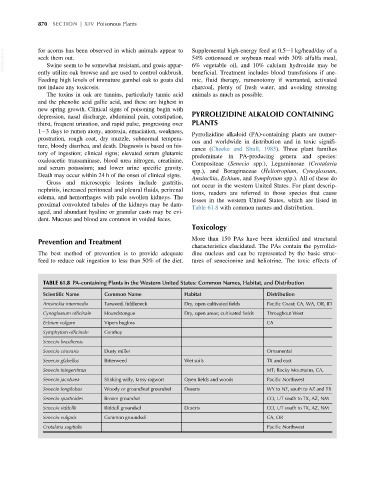Page 915 - Veterinary Toxicology, Basic and Clinical Principles, 3rd Edition
P. 915
870 SECTION | XIV Poisonous Plants
VetBooks.ir for acorns has been observed in which animals appear to Supplemental high-energy feed at 0.5 1 kg/head/day of a
54% cottonseed or soybean meal with 30% alfalfa meal,
seek them out.
6% vegetable oil, and 10% calcium hydroxide may be
Swine seem to be somewhat resistant, and goats appar-
ently utilize oak browse and are used to control oakbrush. beneficial. Treatment includes blood transfusions if ane-
Feeding high levels of immature gambel oak to goats did mic, fluid therapy, rumenotomy if warranted, activated
not induce any toxicosis. charcoal, plenty of fresh water, and avoiding stressing
The toxins in oak are tannins, particularly tannic acid animals as much as possible.
and the phenolic acid gallic acid, and these are highest in
new spring growth. Clinical signs of poisoning begin with
depression, nasal discharge, abdominal pain, constipation, PYRROLIZIDINE ALKALOID CONTAINING
thirst, frequent urination, and rapid pulse, progressing over PLANTS
1 3 days to rumen atony, anorexia, emaciation, weakness,
Pyrrolizidine alkaloid (PA)-containing plants are numer-
prostration, rough coat, dry muzzle, subnormal tempera-
ous and worldwide in distribution and in toxic signifi-
ture, bloody diarrhea, and death. Diagnosis is based on his-
cance (Cheeke and Shull, 1985). Three plant families
tory of ingestion; clinical signs; elevated serum glutamic
predominate in PA-producing genera and species:
oxaloacetic transaminase, blood urea nitrogen, creatinine,
Compositeae (Senecio spp.), Leguminosae (Crotalaria
and serum potassium; and lower urine specific gravity.
spp.), and Boraginaceae (Heliotropium, Cynoglossum,
Death may occur within 24 h of the onset of clinical signs.
Amsinckia, Echium, and Symphytum spp.). All of these do
Gross and microscopic lesions include gastritis,
not occur in the western United States. For plant descrip-
nephritis, increased peritoneal and pleural fluids, perirenal
tions, readers are referred to those species that cause
edema, and hemorrhages with pale swollen kidneys. The
losses in the western United States, which are listed in
proximal convoluted tubules of the kidneys may be dam-
Table 61.8 with common names and distribution.
aged, and abundant hyaline or granular casts may be evi-
dent. Mucous and blood are common in voided feces.
Toxicology
Prevention and Treatment More than 150 PAs have been identified and structural
characteristics elucidated. The PAs contain the pyrrolizi-
The best method of prevention is to provide adequate dine nucleus and can be represented by the basic struc-
feed to reduce oak ingestion to less than 50% of the diet. tures of senecionine and heliotrine. The toxic effects of
TABLE 61.8 PA-containing Plants in the Western United States: Common Names, Habitat, and Distribution
Scientific Name Common Name Habitat Distribution
Amsinckia intermedia Tarweed, fiddleneck Dry, open cultivated fields Pacific Coast; CA, WA, OR, ID
Cynoglossum officinale Houndstongue Dry, open areas; cultivated fields Throughout West
Echium vulgare Vipers bugloss CA
Symphytum officinale Comfrey
Senecio brasiliensis
Senecio cineraria Dusty miller Ornamental
Senecio glabellus Bitterweed Wet soils TX and east
Senecio integerrimus MT; Rocky Mountains, CA,
Senecio jacobaea Stinking willy, tansy ragwort Open fields and woods Pacific Northwest
Senecio longilobus Woody or groundleaf groundsel Deserts WY to NE, south to AZ and TX
Senecio spartioides Broom groundsel CO, UT south to TX, AZ, NM
Senecio riddellii Riddell groundsel Deserts CO, UT south to TX, AZ, NM
Senecio vulgaris Common groundsel CA, OR
Crotalaria sagittalis Pacific Northwest

